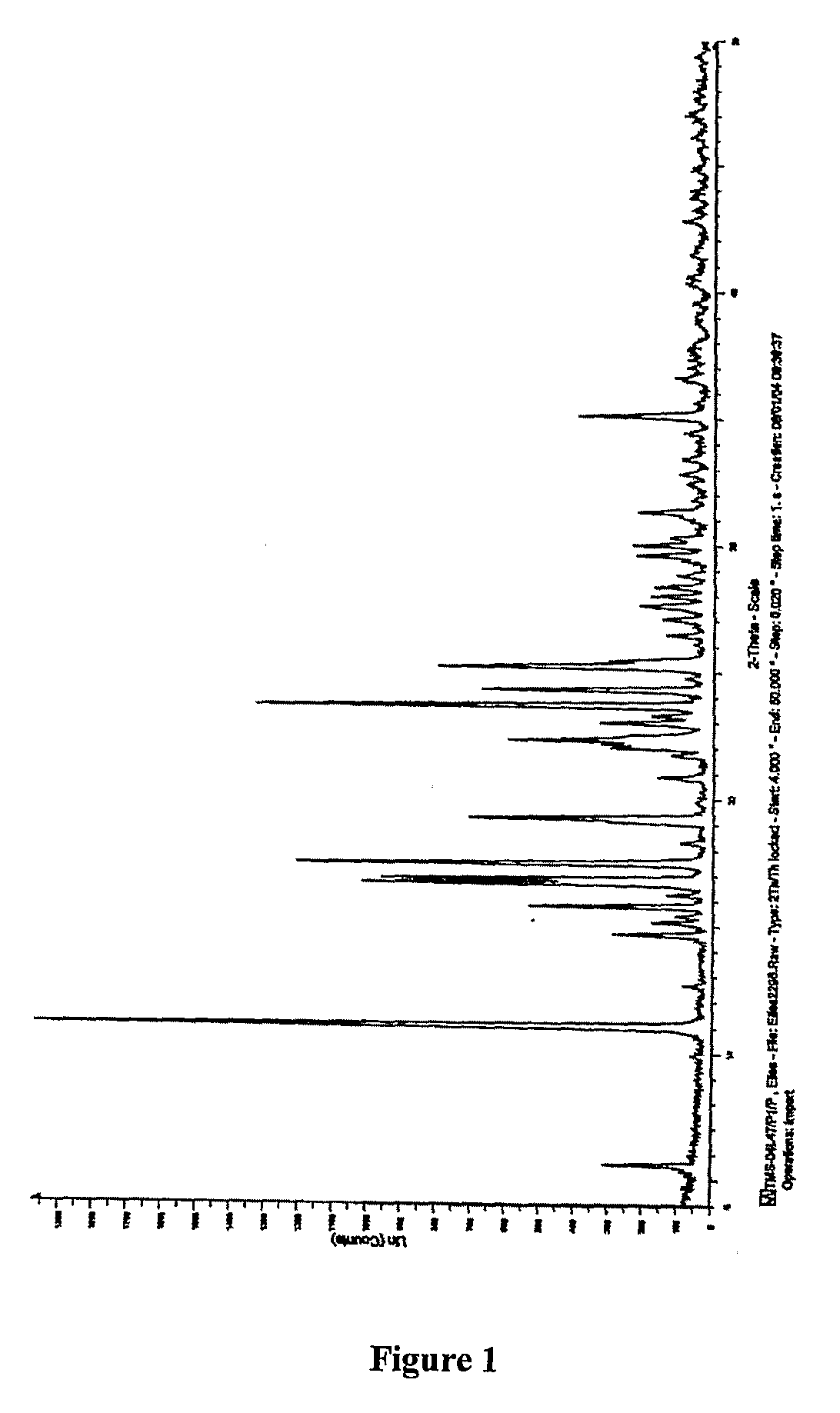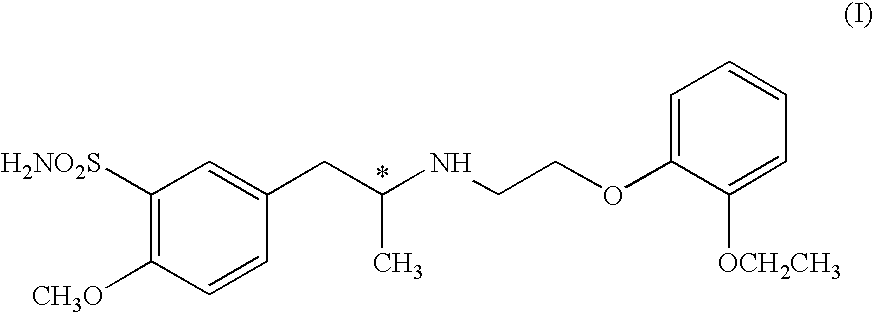Process for the Preparation of Tamsulosin
a technology of tamsulosin and tamsulosin, which is applied in the field of preparation of tamsulosin, can solve the problems of economic disadvantage, general undesirable commercially, and use economically disadvantageous purification processes to isolate products, and achieves efficient separation, reduces or avoids the presence of by-products, and reduces the amount of by-products
- Summary
- Abstract
- Description
- Claims
- Application Information
AI Technical Summary
Benefits of technology
Problems solved by technology
Method used
Image
Examples
example 1
Preparation of (R)-5-(2-aminopropyl)-2-methoxy benzenesulfonamide
[0061]The preparation of (R)-5-(2-aminopropyl)-2-methoxybenzenesulfonamide (reactant-V) is provided according to this example. A mixture of racemic (±)-5-(2-aminopropyl)-2-methoxybenzenesulfonamide (7.9 g, 32.33 mmol) and (1R)-(−)-10-camphorsulfonic acid (7.5 g, 32.28 mmol) is prepared in isopropanol (20 mL) and then stirred for 30 minutes. A precipitate forms and is separated by filtration and then washed with a mixture of isopropanol and water. The obtained precipitated solid is crystallizated from a mixture of isopropanol and water and dried to obtain 4.3 g of salt.
[0062]The obtained salt (4.3 g) is then dissolved in water (25 mL), and the pH is adjusted with ammonia to 10 and then stirred for 1 hour. A precipitate forms and is then separated by filtration, washed with water and dried yielding (R)-5-(2-aminopropyl)-2-methoxybenzene sulfonamide (2 g, 8.18 mmol, 25.31% molar yield).
example 2
Preparation of Tamsulosin Hydrochloride
[0063]Tamsulosin hydrochloride is prepared according to this example. In a round-bottomed flask, 4.8 g (19.65 mmol) of (R)-5-(2-aminopropyl)-2-methoxybenzenesulfonamide or (reactant-V), 16 mL (15.28 g, 91.96 mmol) of triethyl phosphite and 2.8 g (33.33 mmol) of sodium bicarbonate are charged. The suspension is stirred until complete solution at which point, 5.8 g (23.64 mmol) of 2-(o-ethoxyphenoxy)ethyl bromide (reactant-VI) are charged.
[0064]The mixture is stirred at reflux temperature for two hours. After this time, 16 mL of water is charged into the flask and the mixture is stirred at reflux temperature for an additional four hours. The mixture is thereafter cooled down to 0° C. and filtered.
[0065]The filtrate is alkalinized with concentrated ammonia until pH 9 and the resulting suspension is heated up to 40° C. and stirred for one hour. The suspension obtained is then again cooled down to 0° C.
[0066]Then, 30 mL of water and 75 mL of ethyl a...
example 3
Preparation of Tamsulosin Hydrochloride
[0069]Tamsulosin Hydrochloride is also prepared according to this example by first repeating the initial reaction, cooling, and filtering steps of Example 2 to produce the filtrate at 0° C.
[0070]Instead of using ammonia, the filtrate is then alkalinized with DIEA until a pH of 8.5 is obtained, and the desired product is extracted with 2×50 mL of AcOEt. The combined organic layers are then extracted twice with 50 mL of water at pH 6 (adjusted with HCl). The aqueous phases are combined and the pH is again adjusted to 8.5 with DIEA, and the product is then extracted with 2×25 mL of AcOEt.
[0071]The combined organic phases obtained from the extractions are dried over Na2SO4 and the solvent is evaporated to obtain 3.28 g of crude tamsulosin. The content of byproduct as determined by HPLC method 1 was 0.261% (area percentage).
[0072]The residue is dissolved in ethanol (32 mL) and 1.65 mL (7.76 mmol) of ethanol HCl 4.7 N are charged. Then, the mixture i...
PUM
| Property | Measurement | Unit |
|---|---|---|
| Temperature | aaaaa | aaaaa |
| Temperature | aaaaa | aaaaa |
| Temperature | aaaaa | aaaaa |
Abstract
Description
Claims
Application Information
 Login to View More
Login to View More - R&D
- Intellectual Property
- Life Sciences
- Materials
- Tech Scout
- Unparalleled Data Quality
- Higher Quality Content
- 60% Fewer Hallucinations
Browse by: Latest US Patents, China's latest patents, Technical Efficacy Thesaurus, Application Domain, Technology Topic, Popular Technical Reports.
© 2025 PatSnap. All rights reserved.Legal|Privacy policy|Modern Slavery Act Transparency Statement|Sitemap|About US| Contact US: help@patsnap.com



